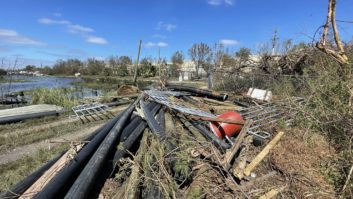Some of us collect postage stamps; others coins or perhaps matchbooks. There are a few individuals who collect vacuum tubes. However, one Ohioan has set a somewhat loftier goal: amassing a collection of broadcast-type radio transmitters.

Gerry Moersdorf shows off the oldest item in his large collection of broadcast transmitters. The Western Electric 443A1 1 kW Doherty dates to the 1940s. Moersdorf notes that it tunes between 550 kHz and 2,750 kHz, allowing it to be used in the old police band for one-way “broadcast” communications.
Gerry Moersdorf began rounding up such transmitters more than 15 years ago, uprooting them from their former workspaces and hauling them back to a large warehouse-type building in a Columbus, Ohio, suburb.
Moersdorf is quite selective, though; not just any broadcast transmitter will do. He’s especially partial to representative examples from the likes of Collins, Gates, RCA and Western Electric — companies that once supplied transmitters for the majority of U.S. radio stations — and they must be vacuum tube-powered “big iron.” He has no interest whatsoever in the compact solid-state high-efficiency pipsqueaks from the last several decades.
“My motto is never operate a transmitter that can’t kill you if it falls over,” said Moersdorf, a former software engineer, who created and sold off a couple of successful computer-related businesses before devoting his energies to rescuing broadcast rigs.
THE PATH FROM COMPUTERS TO BIG IRON
“My background was in digital electronics and software. My first company built a DEC-to-IBM interconnect back in the days when minicomputers were as big as a house. My second company built equipment used for telemetry. I started it in 1980 and spent 20 years building it up to the point where we had 380 employees, but my real interest was in radio, so I sold it about 10 years ago.”
Moersdorf has winnowed his collection down from a high of about 30 transmitters to a more manageable (and easily accommodated) 15, explaining that one factor in the decision was the lack of three-phase power when he recently relocated his collection and manufacturing business to Delaware, Ohio.

Moersdorf’s collection contains only one non-broadcast transmitter, this Collins AN /FRT-24 1 kW base station transmitter built for the U.S. Navy. It tunes 2–30 MHz and was constructed in the mid-1960s.
Asked about why he started collecting these behemoths from radio’s heyday, Moersdorf responded: “It’s a labor of love. I just couldn’t stand to see them wind up in dumpsters. The earliest transmitter I have is a 1940s Western Electric, and it’s an amazing piece of engineering. Seeing something like this pushed into a dumpster is a horror.”
Actually, rescuing electronic items from recyclers and landfills is in Moersdorf’s blood and goes back to his childhood years.
“I grew up in New Jersey, and we lived near a dump — actually in Jersey, everybody lived near a dump — and as kids, we used to go down to the dump to look for ‘All American Fives’ [five-tube AC/DC radio receivers] people had thrown out. We’d tie them to our bicycle baskets by the line cords — we might have had 50 at a time — and then we’d go to the local pharmacy with the self-service tube tester and test the tubes. We’d throw the duds out and put the working tubes into maybe 10 radios out of the 50 — actually, we never bought a single tube from the guy that owned the pharmacy. My mother used to give the radios away to neighbors.”
STILL ON THE AIR
Asked whether these massive yesteryear rulers of the AM band were just for show, Moersdorf, who is a ham radio operator, was quick to show off the mods he’d made to allow the rigs to tune the amateur radio bands.

A portion of the collection’s 15-transmitter lineup. The 2.5 kW CCA “cow killer” is at the extreme left.
“The transmitters that I’ve kept, I’ve converted for operation on the 160-, 75- and 40-meter [amateur] bands,” he said. “The amateur radio world’s AM community is the best community. They have a lot of knowledge and love for transmitters like these, and they don’t operate plastic radios.”
Judging from the number of examples in the collection, Moersdorf’s favorite broadcast transmitter line appears to be the Collins 20 V 1 kW series from the 1950s and beyond. It used 4-400 tetrodes in the modulator and RF output sections, and during its production lifespan developed a reputation for high reliability.
“I have two Collins 20V-2s and three 20V-3s,” said Moersdorf. “One of these is [permanently] located on a West Virginia mountaintop. I’m a member of this group of amateur radio guys who go camping four or five times a year, and we have this campsite on a 3,000-foot mountain there. With the help of a bulldozer, we hauled a shipboard container up there to use as our radio station and then hauled up a 20V-3. We have two diesel generators up there to power it.”
Asked about “extremes” in the collection, Moersdorf singled out two units.

Not all of Moersdorf’s transmitters are kept “stock,” as exemplified by this now one-of-a-kind Gates BC-1F 1 kW model from the early 1950s. (Moersdorf has another with Parker Gates’ factory paint job.)
“The highest-power one is a CCA AM2500D which was made in the 1970s,” he said. “It uses four 4-1000 tubes and can make 7,000 watts. The heaviest is a Collins 20T 1 kW model. With it, we like to talk about pounds-per-watt, not watts-per-pound. It came out in 1946 and weighs 5,700 pounds. It’s built like an armored battleship.”
Moersdorf has been known to travel long distances, if there’s a particularly desirable transmitter that needs reprieval from the dumpster.
“I once went to Nevada to pick up an RCA BTA-1,” he said. “We have a big truck [18-wheeler] we use for this. I got my commercial driver’s license just so I could go out and pick up transmitters in the truck.”
SERIOUS AUDIO AMPLIFICATION
Moersdorf noted that the truck had also served as a mobile showroom for another of his enterprises, Audio Power Labs, which manufactured high-end audio amplifiers.
“The audio business came about because of my love of tubes and the sound of tube amplifiers,” said Moersdorf. “We built two amplifier models, a 150-watt monoblock that used the 833 [triode]. We also made a 50-watt that was based on the 572.”
Moersdorf observed that his audio products weren’t intended for those satisfied with an MP3 player and earbuds. While they were in production, a pair of the 833 monoblocks would have set you back a cool $140,000, and the “low-end” 572 model sported a $10,000 price tag for a single unit.
“We had one with an outrageous price point and one at a semi-outrageous price point,” said Moersdorf, noting that in addition to the six-figure outlay for the 833 monoblocks, the consumer likely would have had to pony up an additional sum for an electrical contractor. “You’d need two 20-amp dedicated outlets to power them.”
Asked who would be in the market for such amps, Moersdorf answered “eclectic people.”
“They were more for our age [translation : the older demographic], and the market was quite limited.”
Moersdorf manufactured the tube amps for about five years before discontinuing production in 2016.

Moersdorf and his “Big Bertha” 1946 Collins 20T. It was designed for 1 kW operation and weighs in at a whopping 5,700 pounds. (That’s less than 0.2 of a watt per pound.)

Two of Moersdorf’s set of five Collins 20V Series of 1 kW rigs. All have been modified for use on the amateur radio 40-, 75- and 160-meter bands.
Part of the problem in attracting buyers for high-end audio, he said, is the greying of America. “When you try to map out the intersection between people who are interested in high-end audio and those who are patient enough to sit in a room and seriously listen, you have a very small Venn diagram. My kids have the attention span of a gnat. They’re not going to sit around and listen; they’d rather just stream some audio off their phones.”
He now limits his manufacturing business to a much smaller and less-expensive device for monitoring AC power quality.
BLAME THIS ONE ON THE COW
One of Moersdorf’s most unusual transactions was a package deal consisting of a pair of 5 kW CCA transmitters and a 500-watt Raytheon rig.
“I actually bought an entire 5 kW radio station to get these,” recounted Moersdorf. “This was in southern Kentucky. The reason that I got to buy it was that the station had been killed by a cow. It had its sticks out in a cow field and one of the cows nosed its way into a tuning house and managed to blow up the transmitter. The guy running the station wanted to get back on the air and bought the 500-Watt Raytheon and got the FCC to allow him to temporarily run at lower power. He then found another 5 kW CCA and took parts out to replace the burned-up parts in the first transmitter. However, these got burned-up too. He petitioned the FCC to allow [permanent] 500 Watt operation for something like four years, but wasn’t successful and finally gave up and went off the air, as he had an FM station too.
“I actually bought an entire 5 kW radio station to get these,” recounted Moersdorf. “This was in southern Kentucky. The reason that I got to buy it was that the station had been killed by a cow. It had its sticks out in a cow field and one of the cows nosed its way into a tuning house and managed to blow up the transmitter. The guy running the station wanted to get back on the air and bought the 500-Watt Raytheon and got the FCC to allow him to temporarily run at lower power. He then found another 5 kW CCA and took parts out to replace the burned-up parts in the first transmitter. However, these got burned-up too. He petitioned the FCC to allow [permanent] 500-Watt operation for something like four years, but wasn’t successful and finally gave up and went off the air, as he had an FM station too.
“The story is that the cow killed the AM station, but in the end, the station apparently killed the cow also. Two weeks after it blew up the transmitter, they found it dead in the field. I went in with a Gradall and removed all three transmitters.”

Until fairly recently, Moersdorf’s Audio Power Labs operation produced high-end high-fidelity amplifiers, including this 150-watt beauty. It was inspired by the 833 graphite anode transmitter triode. A pair of the monoblock amps cost $140,000. If you want a set of your own, you’ll need to act quickly as only a few remain in stock.
Moersdorf admits that restoring vintage transmitters isn’t always easy due to a lack of parts, and working on them involves a number of dangers — high voltage, mercury vapor rectifiers, asbestos, PCBs and X-ray radiation — but he really has no use for modern machines.
“I only collect transmitters with glowing objects in them — tubes!”
While Moersdorf doesn’t maintain his collection of transmitters as a museum, visitors are always welcome. Contact him via email ([email protected]) to set up an appointment.
Additional photos of Moersdorf’s collection are available online through the QRZ amateur radio website, www.qrz.com. After accessing the site, search for his amateur radio call sign KC8ZUL.
James O’Neal is a retired broadcast engineer who worked in that field for some 37 years before joining Radio World’s sister publication, TV Technology, to serve as its technology editor for nearly a decade. He is a regular contributor to both publications.












